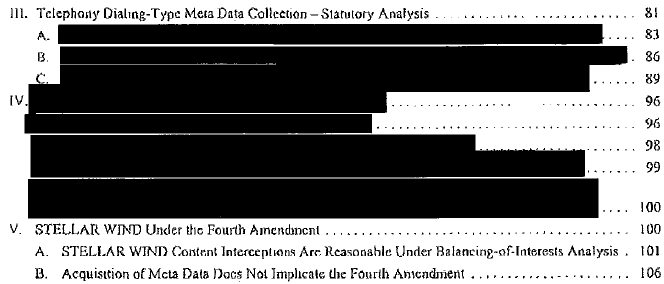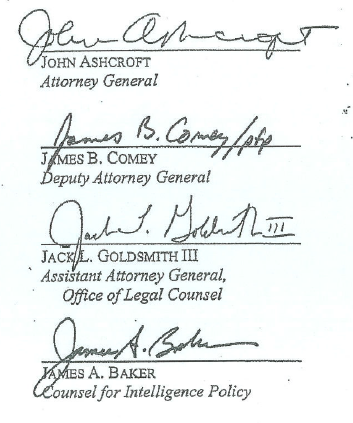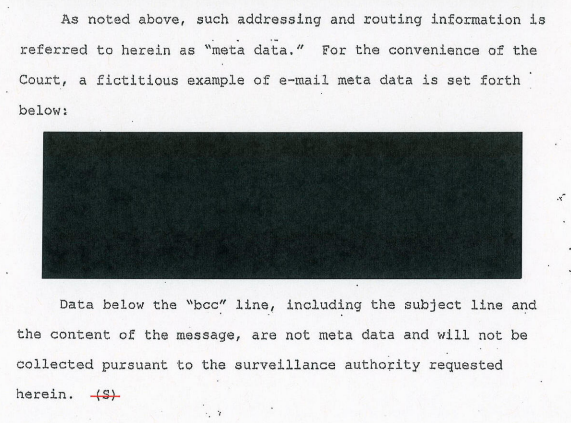Hospital Hero Jack Goldsmith, the Destroyer of the Internet Dragnet, Authorized the Internet Dragnet
As I noted earlier, I think the re-release of Jack Goldsmith’s May 6, 2004 OLC memo authorizing Stellar Wind is meant to warn Congress that the Executive does not believe it needs any Congressional authorization to spy on every American — just in time for the USA Freedom Act debate in the Senate. This is exactly parallel to similar provocations during the Protect America Act debate. In the past, such provocations led Congress to capitulate to Executive branch demands to tailor the program to their wishes.
That earlier post, however, implied that this warning pertains primarily to the phone dragnet.
It doesn’t. The warning also applies to the Internet dragnet (and I suspect that stories about the heroic hospital heroes shutting down the Internet dragnet have been dramatically overblown).
One of the very few things — aside from the name STELLAR WIND, over and over, as well as references to content collection that could have been released after President Bush admitted to that part of the program in 2005, and the title Secretary of Defense — that has been newly revealed is this bit of the Table of Contents (here’s the previous release for comparison).
It shows that the memo discusses content, discusses telephony metadata, discusses something else, then concludes that content and metadata are both kosher under the Fourth Amendment. That already makes it clear that part IV is about metadata. The last sentence of the first full paragraph on page 19 does, too. Page 7 makes it clear that Fourth Amendment analysis applies to “both telephony and e-mail.” Much later in the memo, it becomes clear this section — pages 96 to 100 — deals with Internet metadata.
In fact, the only substantive newly unredacted parts of the memo appear on 101 (PDF 69) and then from 106 to 108.
All of this new information makes it clear that Goldsmith asserted that Smith v. Maryland applied for metadata — and applied to both phone and Internet metadata. Remarkably, in that analysis, the government keeps at least one paragraph addressing phone metadata hidden, but reveals the analysis at 106-7 (PDF 74-75) that applies to Internet. (Goldsmith’s claim that Internet users can get providers to turn off spam, at the bottom of 107, is particularly nice.)
In perhaps the most interesting newly released passage (out of the roughly 5 pages that got newly released!), Goldsmith absolves himself of examining what procedures the government was using in its “metadata” collection.
As for meta data collection, as explained below, we conclude that under the Supreme Court’s decision in Smith v. Maryland, 442 U.S. 735 (1979), the interception of the routing information for both telephone calls and e-mails does not implicate any Fourth Amendment interests.85
85 Although this memorandum evaluates the STELLAR WIND program under the Fourth Amendment, we do not here analyze the specific procedures followed by the NSA in implementing the program. (101/PDF 69)
I find this utterly damning, given that we know that, for the following 5 years, the government would lie to FISC about whether their “metadata” contained content. Even the OLC opinion built in the Executive’s ability to collect content in the guise of metadata!
In any case, what is clear — again, just in time to impact the debate over USA Freedom, for which prospective call record collection might or might not be limited to telephone content — is that rather than legally shutting down the Internet dragnet in 2004, Jack Goldsmith authorized it.
And that authorization remains in place, telling the Executive it can collect Internet (and phone) “metadata” whether or not FISC or Congress rubberstamps it doing so. Not only that, but telling the Executive this analysis holds regardless of how inadequate their procedures are in implementing this program to ensure that no content gets swept up in the guise of metadata (which of course is precisely what occurred).
So the Administration, in releasing this “newly unredacted” memo did one thing. Tell Congress it will continue to collect phone and Internet “metadata” on its own terms, regardless of what Congress does.
Only one thing could alter this analysis of course: if the Courts decide that Smith v. Maryland doesn’t actually permit the government to collect all metadata, plus some content-as-metadata, in the country, if they say the Executive can’t actually collect “everything there is to know about everybody and have it all in one big government cloud,” as 2nd Circuit Judge Gerard Lynch described the implications of what we now know to be Goldsmith’s logic on Tuesday. But the courts are going to stop analyzing this question as soon as Congress passes USA Freedom Act. Moreover, the last check on the program — the unwillingness of providers to break the law — will be removed by the broad immunity provision included in the bill.
Not only didn’t Jack Goldsmith heroically legally shut down the Internet dragnet in 2004 (clearly President Bush did make several modifications; we just still don’t know what those are). But he provided a tool that is likely proving remarkably valuable as the Executive gets Congress and privacy NGOs to finish signing off on their broad authority.
The hospital heroes may have temporarily halted the conduct of the Internet dragnet — even while telling Colleen Kollar-Kotelly she had to rubber stamp ignoring the letter of the law because Congress couldn’t know about the dragnet — but they didn’t shut it down. Here it is, legally still operating, just in time to use as a cudgel with Congress.
Update: One other thing other reporting on this is missing — and not for the first time — is that whatever change they made to the Internet dragnet, it was by no means the only change after the hospital confrontation. They also took Iraqi targeting out (in some way). And there was a later April 2 modification that appears to have nothing to do with NSA at all (I have my theories about this, but they’re still theories). So it is too simple to say the hospital confrontation was exclusively about the Internet dragnet — the public record already makes clear that’s not the case.



